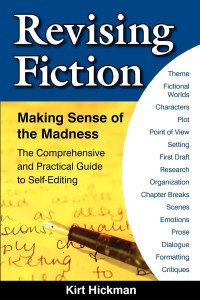by Kirt Hickman
Every scene you write will take place somewhere. In other words, every scene will have a setting. You must transport your readers to that setting. How do you do that effectively?
Determine Setting Elements
First, ask yourself: What impression do I want to make? That the place is desolate? Opulent? Filthy? Dangerous? Foreign? Something more subtle? Choose details that can be experienced by each of the five senses, that will promote the impression you want to make. Work these details into the action of the scene.
Second, find ways for your setting to meaningfully affect your characters and plot. I’m not talking about having your character sit on the beanbag chair, lean on the granite countertop, or walk across the plush, forest-green carpet. I’m talking about using the fountain pen on the desk as a murder weapon, encoding a message that your hero must decipher into the wall tapestry, or shooting a hole through a window that looks out upon the vast vacuum of space while your characters are standing nearby. These kinds of elements will force your characters to interact with their setting. It will make the setting an integral part of your story.
Describe the Setting
When a character first walks into a setting, don’t stop the action to describe every nuance of the place. Better yet, don’t stop the action at all. The original prologue of my science fiction novel, Worlds Asunder, could have begun:
The traffic control room was small. It had two rows of computer terminals. Behind them sat the traffic controllers, facing a central holographic display that showed the current traffic patterns. Two federal agents stood behind Director Snider. The smell of sweat hung in the air. Suddenly, an alarm sounded.
Find a way to work these details into the action of the scene:
Director Jack Snider pulled at the collar of his jump suit in the sweat-fouled air of the traffic control room. He would have paced the aisle behind the second tier of computer terminals if it wouldn’t have betrayed his nervousness. As it was, he felt trapped. The federal agents who stood behind him, looking past his shoulders, made him uneasy, claustrophobic.
“Something’s wrong,” Chavez, the controller, said. Her voice, edged with tension, carried in the small room.
Snider’s heart surged. Trajectory traces crisscrossed the holographic display that dominated the front of the room. The muted voices of the controllers speaking into their comm links died into silence as the trajectory displayed for the Phoenix turned red and separated from the green line of the ship’s assigned flight path. An alarm sounded, reverberating off the walls and ringing in Snider’s brain.
Enhance the Description
Find opportunities to show how the day-to-day life of your character differs from that of the reader who wants your story to carry her away from her mundane world. Bring out the setting elements that are specific to your setting’s time period, country, or culture. If your story takes place in the present day, show setting elements that are specific to your character or his situation. If he’s a cop, show him cleaning his gun or escorting handcuffed prisoners through the police station. Make him sweat in his Kevlar vest. Include the sounds of sirens and the clanging of iron doors, and have him say something only a police officer would say. Now the reader has a sense of what your character’s world is like.
Consider this excerpt from the opening scene of Worlds Asunder:
Chase sucked the last of the coffee from his seal-pak mug, then checked the date for probably the fifth time that day. Just two more weeks to retirement. Then he could go home to Earth and what was left of his family.
In this paragraph, Chase holds not just a mug, but a seal-pak mug. The reader doesn’t know exactly what this is, but with a reference to the slight lunar gravity a few sentences later, she can fill in the blanks. The reader also knows from this paragraph that Chase is not on Earth, which certainly makes his setting different from the reader’s here and now.
Describe from your Character’s Viewpoint
Finally, make sure you’ve described your setting in a way that reveals the viewpoint character’s attitude and emotional state. Is the room cramped, or cozy? Is it cluttered, or lived in? Are the furnishings antiques, or are they just old and outdated?
Do all of these things and you will immerse your reader in your character’s world, which is where she needs to be if she’s going to buy into your story.
 Kirt Hickman is a technical writer turned fiction author. His books include three sci-fi thriller novels Worlds Asunder (2008), Venus Rain (2010) and Mercury Sun (2014), the high fantasy novel Fabler’s Legend (2011), and the writers’ how-to Revising Fiction: Making Sense of the Madness (2009).
Kirt Hickman is a technical writer turned fiction author. His books include three sci-fi thriller novels Worlds Asunder (2008), Venus Rain (2010) and Mercury Sun (2014), the high fantasy novel Fabler’s Legend (2011), and the writers’ how-to Revising Fiction: Making Sense of the Madness (2009).
This article was originally published in the April 2010 issue of SouthWest Sage, and is reprinted here by permission.



Leave a Reply